what type of information does email forensics attempt to uncover
If y'all are interested in everything y'all can perchance do to mitigate phishing, bank check out our anti-phishing eastward-book or phishing mitigation webinar, both dedicated to fighting phishing. But no affair how much yous try to prevent social applied science and phishing from getting to your end users, some corporeality of it will finish up in the user'southward inbox, browser or phone. No preventative defense has yet to defeat phishing attacks. Considering of this, all end users should be trained to spot social engineering and phishing which made it past preventative controls – and taught what to practise (which is hopefully report and delete). In that location are times when an end user will receive an e-mail or a website pop-upwards (or a message over some other media aqueduct like a text message or vocalisation call), where it is non readily apparent if the message is a social engineering or phishing assail. In those cases, the terminate user tin can endeavour to expect for clues which will better help them decide the legitimacy or report that potential phishing instance to someone else who tin bear an investigation. If the legitimacy cannot be determined, the phishing attempt should be ignored, reported and deleted. "When in dubiousness, craven out!" But in most cases, the social engineering and phishing example can be investigated by the finish user or the advisable IT person to make up one's mind legitimacy. Hither are the steps anyone can take to forensically examine a social engineering or phishing set on. If the requestor is asking you to log in to a website to verify something, avoid using the URL link supplied in the request. Instead, go to the legitimate website the requestor is referencing, log in to that website and see if the same request is present. If it is not, then normally the request is bogus. Not always, but nearly of the fourth dimension. When in dubiousness, chicken out. Whatever unexpected requests to open up a document should first be verified some other way, such as calling the requestor on a previously known or legitimate phone number. Never call a requester to verify something using the phone number supplied in the bulletin. Those included numbers often lead to fake companies with false receptionists. KnowBe4 has a nifty "Social Engineering Reddish Flags" PDF that you can review and send to anyone. Shown below, it includes over 20 dissimilar mutual signs of social engineering. Information technology is a slap-up summary PDF. Y'all tin find a longer blog article where it is discussed hither. For instance, I go to a website I dearest and trust and visit all the fourth dimension. And this time, for the first time ever, it tells me that I need to upgrade some software program to view content on the website. If this is the first time this website has always asked me to do it, and it is unexpected, be very suspicious. Phishing tin actually be more difficult to recognize. Sometimes the request is coming from someone you know and trust, and they are request yous to exercise something y'all take been waiting on, such equally wire money to a depository financial institution as an escrow payment during a mortgage loan approving process. Computers in escrow companies accept been compromised and the attacker sends the payment data to a waiting recipient and all the information in the email is expected, but the only fraudulent, inverse information is the wiring instructions. These types of phishes are border cases. In the case of mortgage escrow fraud, all recipients of wiring instructions should e'er call the escrow visitor at their legitimate, verified phone number, to ostend all of the wiring instructions commencement. By following the previous rule, "Exist very suspicious virtually whatsoever unexpected email or request, even if coming from a known and good electronic mail address or website, asking a potential victim to practise something potentially dangerous to their ain business relationship or company", whatever potential victim tin can diminish the most take chances for the majority of social engineering phishing cases. For instance, to see email headers in Microsoft Outlook, open any email so cull File, Properties, Net Headers (see case below). See email headers in a browser while using Google Gmail, Open up electronic mail, click on three dots on correct, and click on Show original. No thing how I become to the header, I unremarkably re-create information technology to a text document for easier viewing and searching. First, almost servers and services which assist in routing an email from source to destination (known as mail service transfer agents or MTAs), add information to an e-mail's headers. They practice non have to, but virtually do. Second, the information in the header is unremarkably shown last in first out, meaning the earliest information is before on in the header information. The pinnacle of an e-mail header is from the latest MTAs and the data from the first MTA is near the bottom of the header. Third, whatsoever MTA can alter some other MTA'south email header information or post fraudulent information into a header. So, ultimately you cannot trust what is in an email's header. With that said, 99% of the time, an email's header information is valid and legitimate. Just always keep in the back of your mind that they can be falsified and you can never truly rely on them. The start thing I usually do when reviewing an electronic mail header is to expect for the SPF, DKIM and DMARC header information, if it exists in the header. It commonly does. SPF, DKIM and DMARC are acronyms for global phishing standards. They exist to determine if an email challenge to be from a sure domain were actually from an email server authoritative for that domain. Note: If you want to acquire more, you can watch my 1-60 minutes webinar well-nigh SPF, DKIM and DMARC Suffice to say, if SPF, DKIM and/or DMARC records exist, y'all want them to say "pass" versus "fail". Run across some examples below. The first image is of an SPF tape that passes: There is a lot of other information that tin be gleaned from an email header, especially IP addresses and domain names. The simply ones that really affair are the first one shown at the lesser of the e-mail header. In detail, I look for the first "Received:" listing at the very bottom of the header: For example, in the sample shown below, the sending domain was te.squad-admin-net with IP accost 185.62.190.159: It is important that you never execute content or click on a suspected URL link on your regular calculator. Content and links can exploit your device or software. Yep, one click can lead to a compromised estimator. Instead, for suspected stuff, open up it up on an isolated computer or isolated virtual machine. The latter is what most forensics investigators do at present. Example virtual automobile software includes: Whichever virtual machine software you use, make sure it is "isolated" from your regular network, with at most, only the power to connect to the Internet. Yous don't want malware or hackers accidentally getting access to your regular, production, network. Make sure any logon accounts and passwords yous use are different than any yous apply for your other work. For instance, I create "throwaway" email accounts in Hotmail and Gmail that I merely employ for picking and playing with social applied science malware, URLs, and file attachments. That way if a hacker or malware is able to "steal" my password(s) or take over my business relationship, I'yard no worse for the wear, and my regular corporate network is not threatened. Note: Some malware programs, if they detect they are running in a virtual machine environment, will leave prematurely or change their beliefs to be seemingly more than innocent. Your virtual prototype should have forensics software installed to assistance investigate any badness yous are running on the virtual car. There'south a lot of forensic software out there you can use. What forensics software do I use? I love free stuff. I'm a large fan of annihilation Microsoft'due south Sysinternals site. It has dozens of free, diagnostic, forensic program. I think almost forensics investigators particularly love Process Explorer, Process Monitor, and Autoruns. Those three programs are worth their weight in gold. Procedure Explorer is good for seeing what executables are running and you can check them against Google's free VirusTotal website, which compares any submitted file'due south hash to ones scanned and recognized past over 70 antivirus engines. If more than two VirusTotal AV engines recognize a submitted file as malware, information technology probably is malicious. If merely 1 or 2 of the over 70 AV engines place a submitted file as malicious, it may be a simulated-positive. Here are some case recaps of forensic investigations I did using rubber, isolated VMs and Sysinternals software: This is email phishing forensics phishing 101. If I become an email, it is the steps I accept, and you can take, to chop-chop determine maliciousness or legitimacy. If I tin can't determine if an email or URL is legitimate or not within a few minutes (and after making a few phone calls), I forrard it to the IT security team to review and I delete it (all at once using my Phish Alert Button). With that said, I think anyone tin determine the legitimacy of 95% or more of emails by following the elementary steps above. Relish your threat hunting! Cyber crime has become an arms race where the bad guys constantly evolve their attacks while yous, the vigilant defender, must diligently expand your know how to prevent intrusions into your network. https://info.knowbe4.com/phishing-forensics The single best thing you tin do to reduce cybersecurity take a chance in your surround is to preclude and mitigate social engineering – phishing in particular. The first and best affair whatever Information technology security administrator should do is to prevent social technology and phishing from getting to their stop users, every bit best they tin. It requires the best, defence-in-depth combination of policies and technical defenses.
The single best thing you tin do to reduce cybersecurity take a chance in your surround is to preclude and mitigate social engineering – phishing in particular. The first and best affair whatever Information technology security administrator should do is to prevent social technology and phishing from getting to their stop users, every bit best they tin. It requires the best, defence-in-depth combination of policies and technical defenses.
Of course, the trunk of the message gives the most clues. If the message is unexpected and requests an action from the receiver that the receiver has never done before for the sender, it should exist highly doubtable (even if coming from a trusted person and valid email accost). The requests tin be a hundred different topics. The most mutual phishing request is a request for login credentials, ordinarily in response to verifying some other action (such as a fake reported security incident). The 2d most common asking is for the potential victim to open a document, which then tries to run an unexpected executable or some other type of potentially dangerous content. The vast bulk of phishing requests involve requests for credentials or to open attached files or to click on embedded URL links.
The vast bulk of phishing emails include visible clues that the bulletin is rogue and not legitimate. Typos and obvious signs that the sender is not familiar with your language are still very common. The other virtually common sign is that the sender's name and included e-mail accost and reply address are often very dissimilar (known as sender address disagreement). The figure below is a dandy example: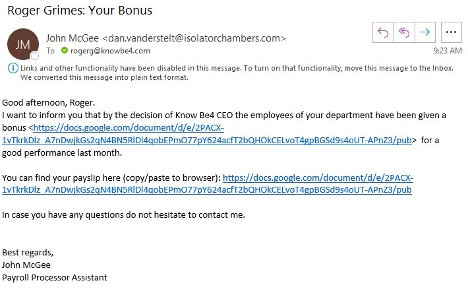
It claims to be from John McGee, simply the sending email accost is conspicuously tied to Dan Vanderstelt. I am never sure why the sender does non try harder to make certain the fake name they are using matches the email address they are using. Must be too difficult to synchronize email addresses with the correct associated names given the amount of phishing emails they are sending using automation tools.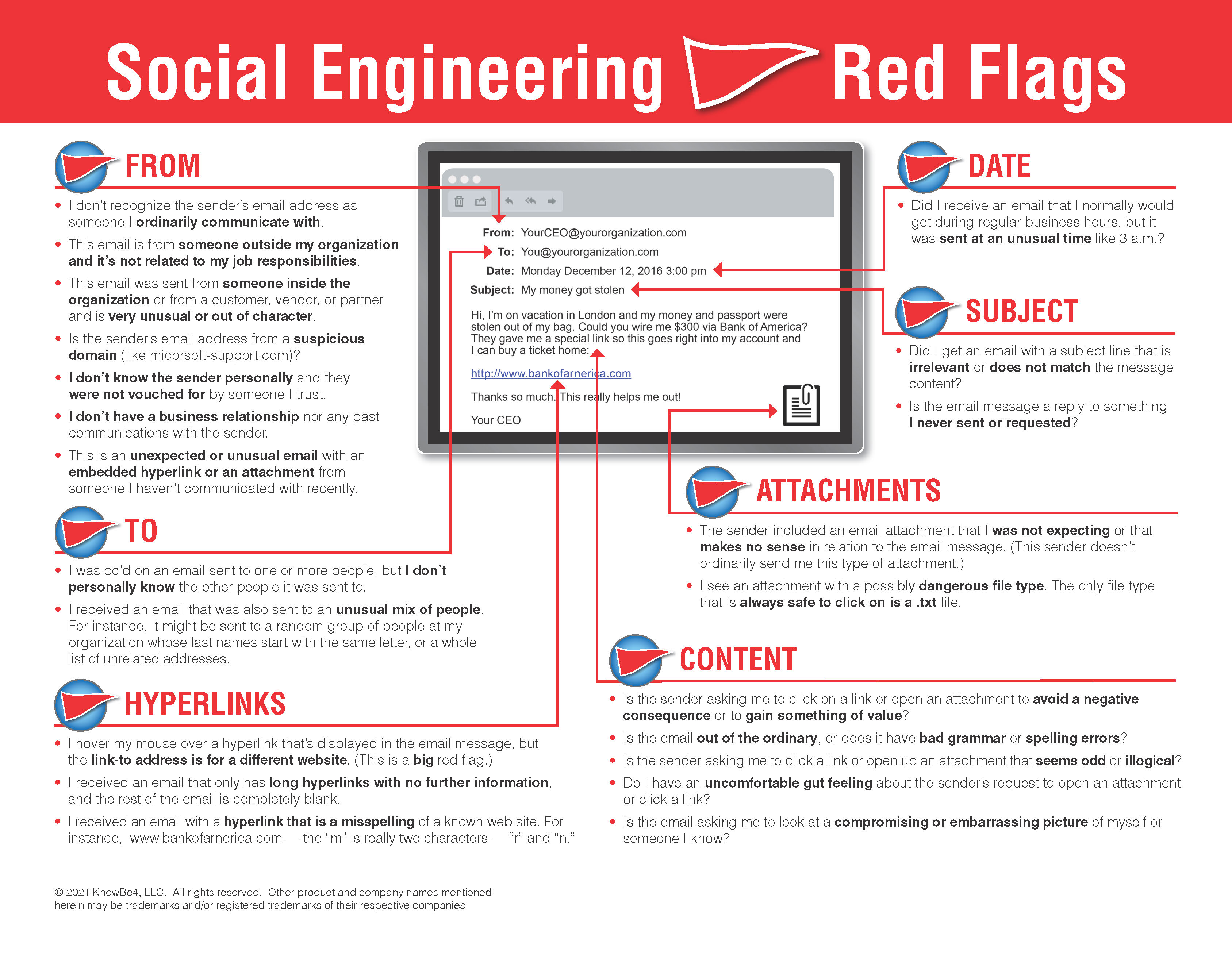
KnowBe4 also has a great PDF summary of mutual rogue URL tricks (shown below) here: . A longer web log article giving more detail to the rogue URL tricks tin can exist found here.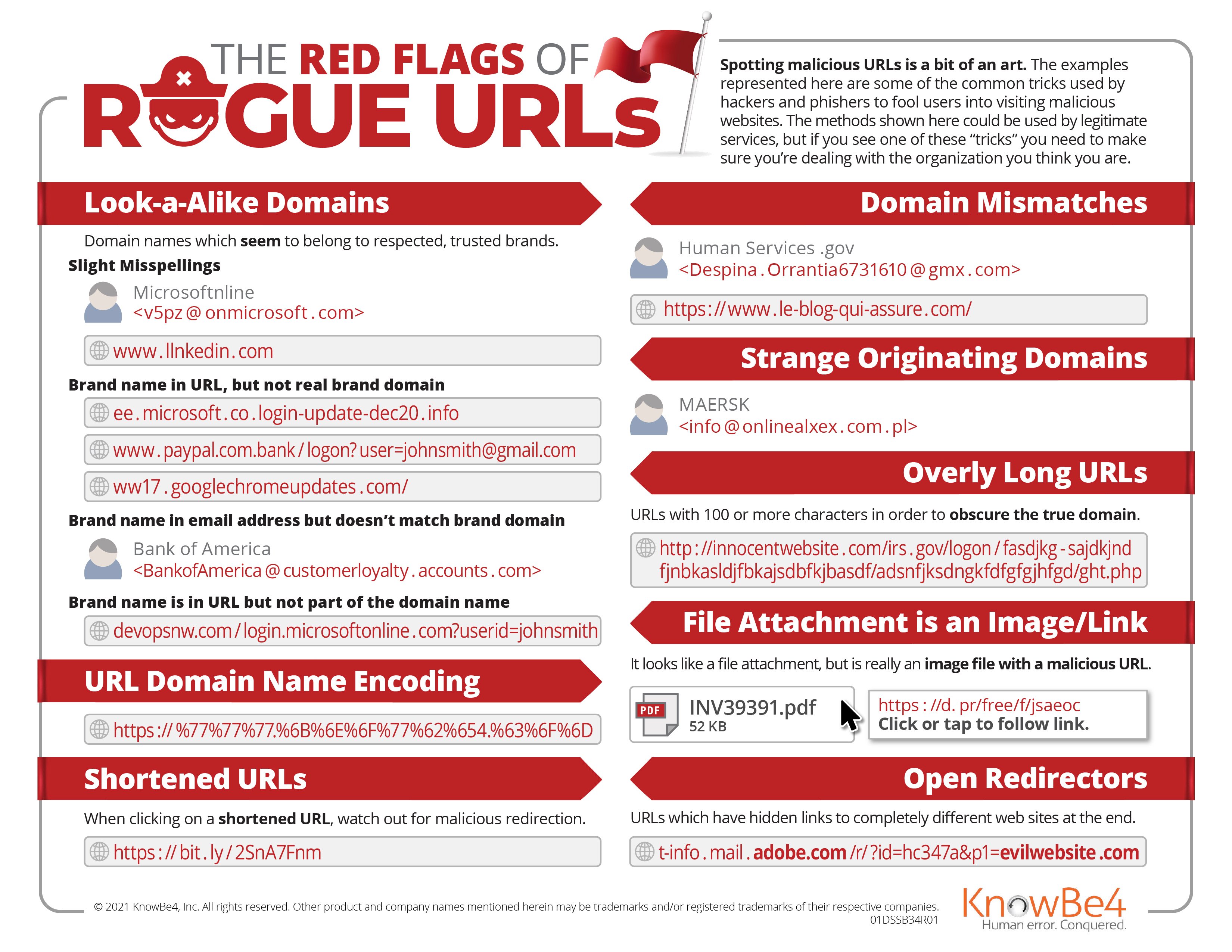
I want to be clear. The best thing to communicate to employees nigh watching out for phishing and social engineering, is to be very suspicious about whatsoever unexpected e-mail or asking, even if it is coming from a known and practiced email address or website. They should exist especially cautious if the email is request a potential victim to do something potentially unsafe to their own business relationship or company.
There will exist times when the request and text of the electronic mail is non enough to determine legitimacy. When this happens, the adjacent matter to do is to look at the electronic mail'southward headers. Every email has header data, which if viewed, can reveal useful information. Every email client has different ways to view the email header information.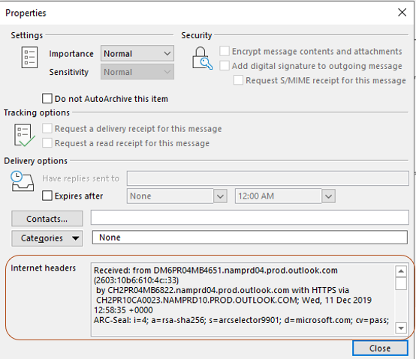
Email headers are e'er very messy, "noisy", things (encounter prototype beneath).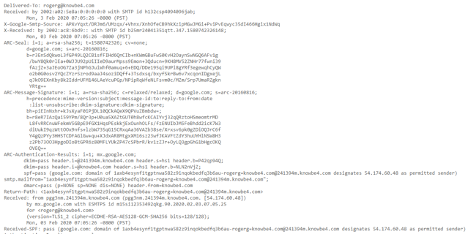
They are full of nearly incomprehensible technical and routing information. For those of us who read them routinely, they by and large make sense. We know what to ignore and what is important. For anyone new to them, they can be a scrap daunting. Here are a few rules: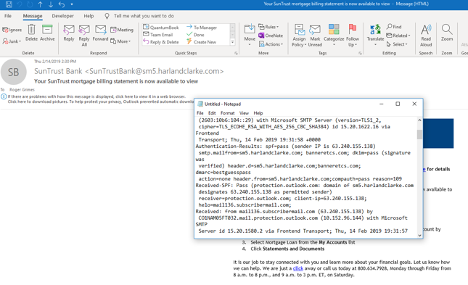
This adjacent record is of an SPF record that fails: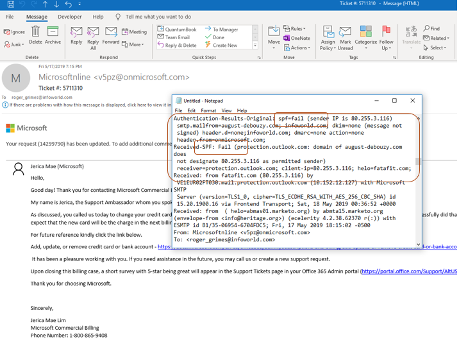
The next effigy below is of a DKIM record indicating a laissez passer:
The side by side figure below is of a DKIM record that failed:
There can be other findings, such as "None" or "Neutral", usually indicating that SPF, DKIM and/or DMARC records were not establish. A failure can likewise be because someone did non configure their SPF, DKIM and/or DMARC records correctly, but if I see "laissez passer" and "verified", then I at to the lowest degree know that the domain that the e-mail claims it was from, information technology really was from.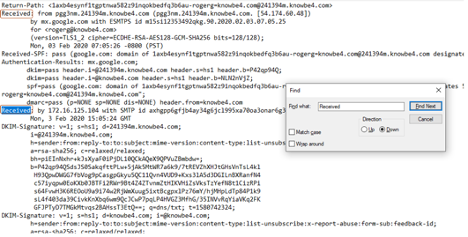
Every bit you can meet in the figure below, there are multiple "Receive:" labels, but we are interested in the very bottom one. That is the email server or MTA that first sent the email. You may also see "X-Originating-IP" (equally shown below). Information technology may be in place of a "Received" label.
Either way, the get-go (at the bottom) "Received" or "X-originating-ip" label will tell yous the first sending server or service. That is who sent it originally. You can then utilise other "lookup" services to convert the IP address or domain name into physical location or company possessor.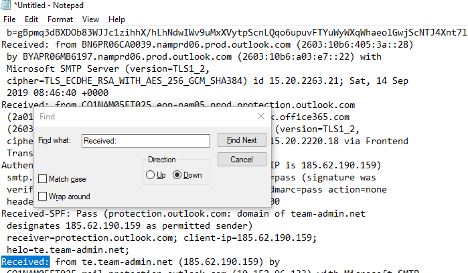
I used an IP address lookup service (they are all over the Internet) to larn that the IP address is located in Russia: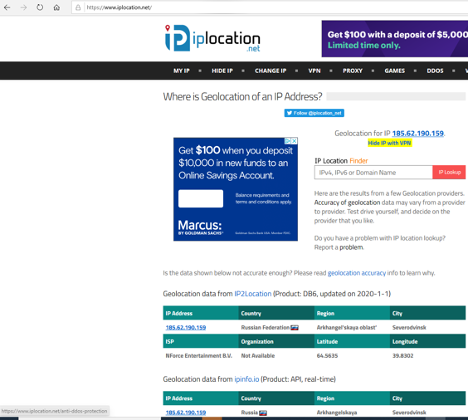
This electronic mail was claiming to be from Microsoft, which is based in Redmond, WA. Russia is a hotbed for malware and ransomware. Knowing nothing else, I would be very suspicious of the email.
In full general, I tend to run a handful of investigative "lookup" services on any found IP addresses or domain names. Ane of the most popular gratuitous and commercial lookup services is Mxtoolbox. Their "Super Tool" lookup is everything most people would need to look up public information about an IP address or domain proper name. Here is an example screenshot I took when researching a domain name (googlechromeupdates.com) that arrived on a confirmed phishing assail e-mail claiming that I need to update my Google Chrome browser using their file zipper: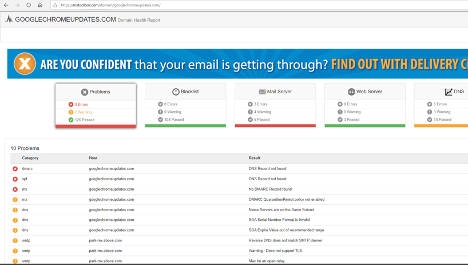
I am a big fan of "blacklist" checks, which will look to see if the domain you are typing in was previously reported as malicious to one of the many dozens of global blacklist services: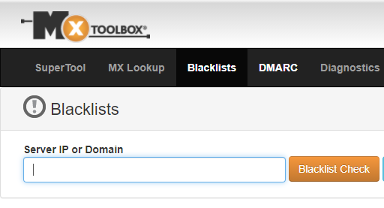
New malicious domains are commonly not on blacklists. It takes a few days to weeks for them to appear, but it is a quick check. And occasionally, it actually shows me that the questioned domain is on someone's blacklist. The following example shows this: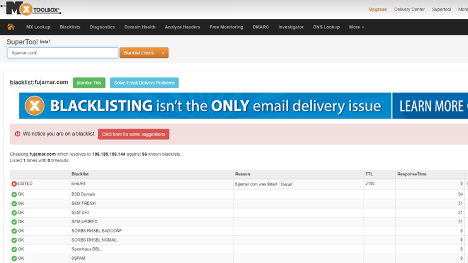
If the suspected email contains a file attachment or URL, you can always endeavor opening it on a "safe", isolated virtual motorcar (VM), which contains forensic software to assistance me analyze it. Whatsoever fourth dimension I become a potentially dangerous electronic mail or URL, I transport it to my "throwaway" dummy email business relationship created solely for me to send dangerous stuff to. Then I open up that email in my safe, isolated virtual automobile, and see what my forensic software shows.
Webinar: Acquire How to Forensically Examine Phishing Emails
In this webinar, Roger Grimes, KnowBe4's Data-Driven Defense force Evangelist, shows you how to become a digital private investigator! You'll learn:
How to forensically examine phishing emails and identify other types of social engineering 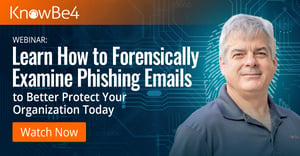

PS: Don't like to click on redirected buttons? Cut & Paste this link in your browser:
Source: https://blog.knowbe4.com/forensically-investigating-phishing-to-better-protect-your-organization
0 Response to "what type of information does email forensics attempt to uncover"
Post a Comment